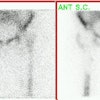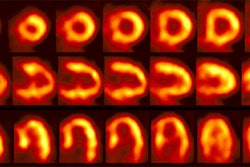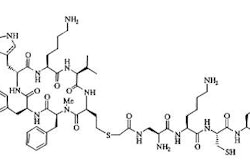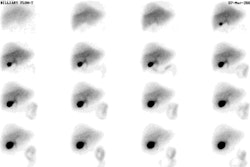PET in Infection Imaging:
General:
PET imaging has several advantages over convention nuclear infection imaging including tomographic scans with excellent spatial resolution and same day imaging [11]. FDG PET appears to be very good for the evaluation of suspected infection of the musculoskeletal system. Activated inflammatory cells demonstrate increased expression of glucose transporters [10]. The physiologic basis of FDG PET in the identification of infection is likely related to the respiratory burst that neutrophils and monocytes experience when exposed to proinflammatory cytokines (e.g., granulocyte?macrophage colony stimulating factor, interleukin-8, and interleukin-6), with the resulting metabolization of large amounts of glucose (ie: inflammatory cells at sites of infection show increased glycolytic activity) [1,2]. Increased splenic activity can be seen in patients with underlying infections- presumably related to increased glucose utilization [10]. In animal models, both hyperglycemia and hyperinsulinemia have been shown to decrease FDG uptake at sites of infection and inflammation [15]. 18F- FDG-labeled white bloods have also be evaluated for use in infection imaging [9].
Metallic implants:
About 400,000 hip and knee arthoplasties are performed annually in the United States [7]. Infection after primary implantation occurs in approximately 1% of hip arthroplasties and 2% of knee arthroplasties [7]. The rate of infection following revision surgery is higher- about 3% for hip and 5% for knee replacements [7]. Approximately one-third of infections develop within 3 months of surgery, another third within 1 year, and the remainder more than 1 year after surgery [7]. FDG PET imaging has been used to evaluate for infected orthopedic prostheses and can assess for the presence of both acute and chronic infectious processes [1]. Advantages of FDG PET imaging over conventional imaging include: 1- FDG accumulates within the site of infection within 60 minutes which provides for rapid patient evaluation; 2- PET imaging has a much higher spatial resolution compared to single photon techniques which allows better distinction between soft-tissue and osseous infection; and 3- FDG PET imaging is less expensive than leukocyte-based labeling techniques [1].
Initially, FDG PET imaging had shown great utility for the evaluation of patients with suspected orthopedic prosthesis infections [1]. Sensitivities of up to 100%, specificities of 88-93%, and accuracies of 97% had been reported with low interobserver variability [1]. Recently, lower sensitivities for infected hip prosthesis have been reported (as low as 22%)- with an overall accuracy of only 69% [6]. This is because aseptic loosening and synovitis can also produce a positive PET exam [6,7]. In aseptic loosening, a foreign body granulomatous reaction to polyethylene particles shed by the prosthesis results in macrophage activation that can produce increased FDG accumulation [6]. Lower specificities have also been reported (between 9% to 44% depending on the criteria used to define infection) [7].
It is clear that the location of abnormal accumulation is an important element in image interpretation [11]. Intense FDG uptake along the bone-prosthesis interface should be considered positive for infection, mild uptake as suspect for loosening, and uptake only in the soft tissues as evidence of synovitis [11].
Unfortunately, regardless of how the images are interpreted, FDG PET imaging appears to be less accurate than 111In-labeled leukocyte/ 99mTc-sulfur colloid marrow imaging [7].
Scans performed earlier than 6 weeks following surgery may be falsely positive [1]. Other causes of false positive exams are sterile inflammation associated with prosthetic loosening and patient motion between emission and transmission scans [1]. FDG uptake around the head and neck of hip prosthesis can be seen commonly in non-infected prostheses [3], whereas increased tracer uptake along the interface between the bone and the prosthesis is suggestive of infection [4].
Vascular graft infection:
Vacular graft infection is an uncommon (0.5-5% of cases) complication associated with a high morbidity and mortality [16]. As a rule, most infections occur within a few months of surgery [16]. The clinical presentation is often non-specific [16]. CT and MR imaging may demonstrate a surrounding abscess collection, but the findings are often inconclusive [16]. PET/CT imaging can aid in more definitive localization of the site of tracer uptake permitting accurate differentiation of graft infection versus adjacent soft tissue infection [16]. In one study, FDG PET/CT was found to have a sensitivity of 93%, specificity of 91%, a PPV of 88%, and a NPV of 96% [16]. False positive results can occur when the infection is adjacent to or surrounding the graft [16]. In the early phases of healing during the first months following surgery, FDG imaging may give false positive results [15]. Mild-to-moderate linear tracer uptake along the graft can be seen in up to 18.5% of non-infected grafts and is likely related to a post-operative foreign-body inflammatory reaction- the finding is more frequent in recently implanted grafts [16].
Osteomyelitis:
Increased FDG uptake can be seen at sites of osteomyelitis [10]. However, false positive exams can occur at sites of acute fracture, in normal healing bone up to 4 months after surgery, and in inflammatory arthritis [10]. Mild FDG accumulation is also seen within the normal bone marrow [10].
Chronic osteomyelitis is typically the result of inadequately treated acute osteomyelitis or it may follow exogenous bacterial contamination related to trauma or surgery [15]. It is characterized by the presence of lymphocytic and plasma cell infiltrates [15]. FDG PET imaging has been shown to have very good accuracy for the evaluation of chronic osteomyelitis [15].
Diabetic Foot:
FDG PET imaging can be used for the diagnosis of diabetic foot infections [8]. FDG PET can be positive in up to 93% of infections, however, precise localization of the site of uptake can be difficult on conventional PET imaging [8]. The use of PET/CT imaging aids in the accurate localization of tracer uptake in order to differentiate between osteomyelitis and soft tissue infection [8].
The effect of hyperglycemia on FDG uptake at sites of infection and inflammation is not well documented [8]. In one study, elevated glucose levels did not seem to affect detection of sites of infection [8].
Fever of unknown origin:
Fever of unknown origin is defined as recurrent fever of 38.3? C or higher, lasting 2-3 weeks or longer, and no diagnosis after appropriate inpatient or outpatient evaluation [15]. Some authors have proposed a subclassification including classic FUO in nonimmunecompromised patients, nosocomial FUO, neutropenic FUO, and FUO associated with HIV infection [15]. There are numerous causes for FUO with infection accounting for 13-43% of cases and neoplasms for 15-25% [10,15]. Other causes include collagen vascular disease, vasculitis (up to 17% of cases of FUO [15]), granulomatous diseases, and drug reaction [10]. In between 10-40% of patients, the underlying disease may remain undiagnosed [15].
FDG accumulates at sites of infection and inflammation and FDG PET imaging has been shown to be more sensitive and more specific than Ga-67 scintigraphy for FUO evaluation [10,11,15]. Additionally- PET imaging can be performed in a much more rapid manner [10]. The reported sensitivity is between 81-93%, and specificity between 86-90% for identifying the source of the FUO [10,15]. Overall, FDG PET can provide helpful information in 25-69% of cases of FUO [10,15].
[15]
CNS infection:
FDG PET imaging can be used to aid in differentiating CNS toxoplasmosis infection from lymphoma in HIV patients [10]. CNS lymphoma typically demonstrates significantly greater FDG accummulation [10].
Spinal infection:
FDG PET imaging has proven to be very useful for the detection of disc space infection. Reported sensitivities of up to 100%, and specificities of up to 100% have been reported [2]. In general, increased FDG uptake is not seen in degenerative endplate abnormalities [2].
FDG-labeled leukocytes:
FDG-labeled leukocytes are also being studied for infection imaging. As with In-111 WBC's, the normal biodistribution of the tracer is to the reticuloendothelial system (bone marrow, liver, and spleen) [13]. Faint activity may be seen in FDG avid organs such as the brain and myocardium, but no significant renal or intestinal activity is seen [13]. Imaging can be performed 3-4 hours after injection, as opposed to the 24 hours required for In-111 WBC imaging [12,13]. Also- the tomographic nature of PET imaging enables more precise localization of sites of tracer accumulation [12]. The whole body and major organ dosimetry estimates from FDG-labeled WBC imaging are similar to those for In-111 WBC imaging [12]. The WBC labeling efficiency of FDG is lower than that of In-111 oxime (about 72% versus 90%) [12,15]. In vivo, about 25% of the activity is released from the leukocytes over 6 hours [15]. However, the overall sensitivity in one study higher than In-111 WBC's (87% versus 73%, but not statistically significant), while specificity, and accuracy were similar [12]. The accuracy was lowest for evaluation of osteomyelitis of the hands and feet [12]. False-positive exams can occur as a result of soft-tissue infection and physiologic accumulation of labeled leukocytes in granulating wounds [12]. Overall reported sensitivity is 86-87%, specificity 86%, PPV 92%, NPV 85%, and accuracy 86% [13].
PET Imaging in Inflammatory Conditions:
Sarcoid:
Sarcoid is a mutlisystem inflammatory disease and FDG accumulation can be seen in active sarcoid lesions [14]. PET imaging offers more rapid clinical evaluation compared to traditional gallium imaging and is more accurate for the detection of extrapulmonary sites of diease [14].
Vasculitis:
Patients with vasculitis typically have nonspecific symptoms of fever, malaise, weight loss, and an elevated ESR [15]. PET imaging has been used to evaluate for large and medium-size vessel vasculitis in patients with Takayasu's and giant cell arteritis (generally for vessels that are larger than 4 mm in diameter) [11,15]. FDG PET imaging is sensitive (77-92%) and highly specific (89-100%) in the diagnosis of large-vessel vasculitis in untreated patients with elevated inflammatory markers [15]. Reported NPV is 85%, and PPV is 100% [11]. PET imaging can be used to monitor disease activity and response to treatment [15]. PET imaging is not reliable for the diagnosis of temporal artery inflammation [15].
REFERENCES:
(1) Radiology 2003; Schiesser M, et al. Detection of metallic implant-associated infections with FDG PET in patients with trauma: correlation with microbiology results. 226: 391-398
(2) AJR2002; Stumpe KDM, et al. FDG positron emission tomography for differentiation of degenerative and infectious endplate abnormalities in the lumbar spine detected on MR imaging. 179: 1151-1157
(3) Eur J Nucl Med Mol Imaging 2002; Zhuang H, et al. Persistent non-specific FDG uptake on PET imaging following hip arthroplasty. 29:1328-33
(4) Nucl Med Commun 2002; Chacko TK, et al. The importance of the location of fluorodeoxyglucose uptake in periprosthetic infection in painful hip prostheses. 23:851-5
(5) J Nucl Med 2003; Palestro CJ. Nuclear medicine, the painful prosthetic joint, and orthopedic infection. 44: 927-929
(6) Radiology 2004; Stumpe KD, et al. FDG PET for differentiation of infection and aseptic loosening in total hip replacements: comparison with conventional radiography and three-phase bone scintigraphy. 231: 333-341
(7) J Nucl Med 2004; Love C, et al. Diagnosing infection in the failed joint replacement: a comparison of coincidence detection 18F- FDG and 111In-labeled leukocyte/ 99mTc-sulfur colloid marrow imaging. 45: 1864-1871
(8) J Nucl Med 2005; Keidar Z, et al. The diabetic foot: initial experience with 18F- FDG PET/CT. 46: 444-449
(9) J Nucl Med 2005; Pellegrino D, et al. Inflammation and infection: imaging properties of 18F- FDG-labeled white blood cells versus 18F- FDG. 46: 1522-1530
(10) J Nucl Med 2005; Love C, et al. FDG PET of infection and inflammation. 25: 1357-1368
(11) Radiol Clin N Am 2005; Zhuang H, et al. Applications of fluorodeoxyglucose-PET imaging in the detection of infection and inflammation and other benign disorders. 43: 121-134
(12) Radiology 2006; Rini JN, et al. PET with FDG-labeled leukocytes versus scintigraphy with 111In-oxine-labeled leukocytes for detection of infection. 238: 978-987
(13) J Nucl Med 2006; Dumarey N, et al. Imaging infection with 18F- FDG-labeled leukocyte PET/CT: initial experience in 21 patients. 47: 625-632
(14) J Nucl Med 2006; Nishiyama Y, et al. Comparitive evaluation of 18F-FDG PET and 67Ga scintigraphy in patients with sarcoidosis. 47: 1571-1576
(15) J Nucl Med 2007; Meller J, et al. 18F-FDG PET and PET/CT in fever of unknown origin. 48: 35-45
(16) J Nucl Med 2007; Keidar Z, et al. Prosthetic vascular graft infection: the role of 18F-FDG PET/CT. 48: 1230-1236






